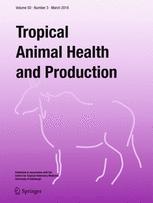Ver ítem
- xmlui.general.dspace_homeCentros Regionales y EEAsCentro Regional Salta - JujuyEEA SaltaArtículos científicosxmlui.ArtifactBrowser.ItemViewer.trail
- Inicio
- Centros Regionales y EEAs
- Centro Regional Salta - Jujuy
- EEA Salta
- Artículos científicos
- Ver ítem
Epidemiology and effect of gastrointestinal nematodes on beef cattle from tropical Argentina
Resumen
The aim of this work was to study the epidemiology and the harmful effect of gastrointestinal nematodes (GINs) on beef cattle in the piedmont forest and grassland region of northwestern Argentina, between March 2015 and March 2016. Sixty weaned female calves were divided into three groups: STG—calves treated systematically with 200 mcg/kg moxidectin every 40–50 days; LTG—calves treated as usually locally implemented, with 200 mcg/kg ivermectin on May 4
[ver mas...]
The aim of this work was to study the epidemiology and the harmful effect of gastrointestinal nematodes (GINs) on beef cattle in the piedmont forest and grassland region of northwestern Argentina, between March 2015 and March 2016. Sixty weaned female calves were divided into three groups: STG—calves treated systematically with 200 mcg/kg moxidectin every 40–50 days; LTG—calves treated as usually locally implemented, with 200 mcg/kg ivermectin on May 4 and August 5; and UTG—calves not receiving treatment. Moreover, a group of 20 untreated first-calving cows was monitored. Eggs per gram of faeces (epg) and faeces cultures were performed. Live weight gain (LWG) was recorded. Differences among groups were compared using analysis of variance and Tukey test. At the start of the experiment, mean epg was from moderate to high (595 ± 480); therefore, this group was treated in May. Mean UTG epg peaked (907 ± 754) in mid-winter, decreasing toward spring. LTG epg only decreased partially after treatment, showing 54.2% of ivermectin efficacy. Epg values of STG were always negligible values (95.8% of moxidectin efficacy). The dominant nematode genus was Cooperia (81.9%), followed by Haemonchus (15.5%). The effect of treatments was evident from middle autumn, with STG showing a significantly (p < 0.002) higher LWG than the other groups. Toward the end of the trial, LWG of STG and LTG increased by 27.2 and 8.2%, respectively, to those of UTG. This preliminary study showed a winter epg peak and a negative effect of GINs on LWG, even in moderately infected calves.
[Cerrar]

Fuente
Tropical animal health and production : 1–6. (December 2017)
Fecha
2017-12
ISSN
0049-4747 (Print)
1573-7438 (Online)
1573-7438 (Online)
Formato
pdf
Tipo de documento
artículo
Palabras Claves
Derechos de acceso
Restringido
 Excepto donde se diga explicitamente, este item se publica bajo la siguiente descripción: Creative Commons Attribution-NonCommercial-ShareAlike 2.5 Unported (CC BY-NC-SA 2.5)
Excepto donde se diga explicitamente, este item se publica bajo la siguiente descripción: Creative Commons Attribution-NonCommercial-ShareAlike 2.5 Unported (CC BY-NC-SA 2.5)

